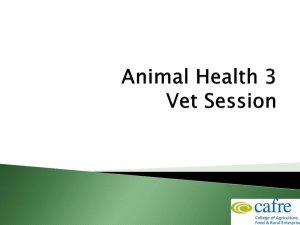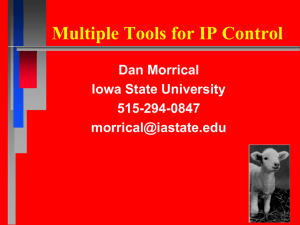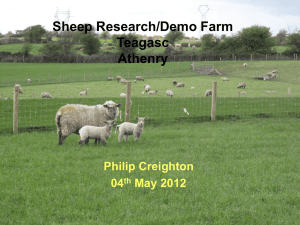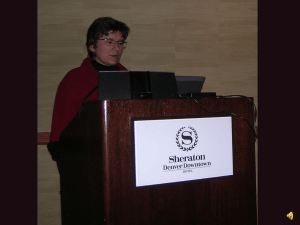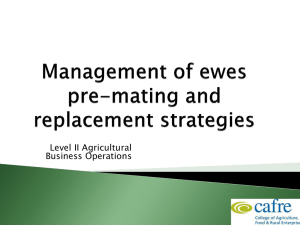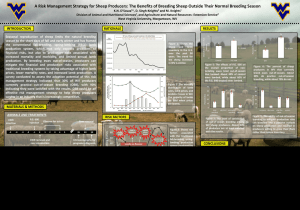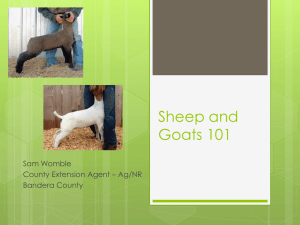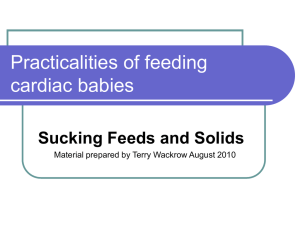Unit 10: Sheep Feeding
advertisement
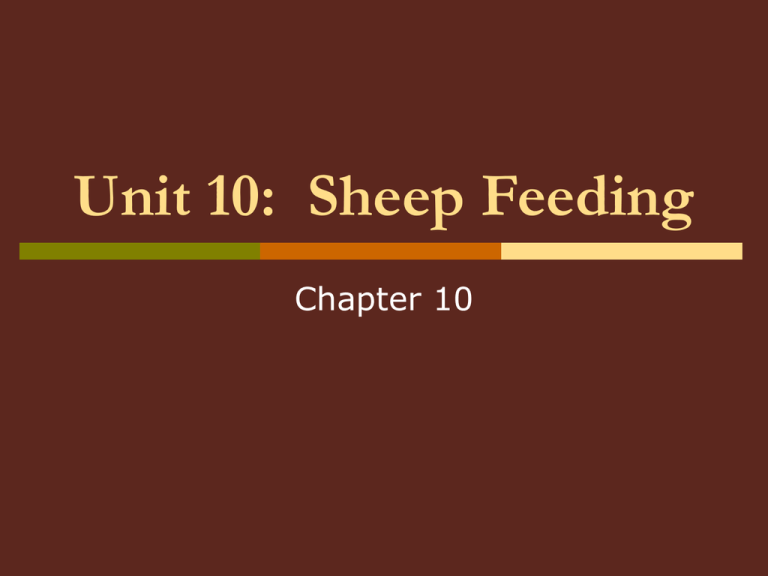
Unit 10: Sheep Feeding Chapter 10 Unit 10: Sheep Feeding Unit 10 Objectives: Outline life-cycle feeding programs for sheep Knowledge of nutrient needs and additive options Understand nutrient related diseases and disorders Unit 10: Sheep Feeding Largest single cost of production in all types of sheep operations Must support optimum production, promote efficiency, be economical to feed, minimize metabolic problems Breeding Flock Ewes are most important to sheep operations Produce wool Raise lambs Both greatly influenced by nutrition Unit 10: Sheep Feeding Genetics are important, but the feeding program is crucial Sheep producers can realize more income over investment than all other meat animal producers Recommended flock size is 100 or more ewes, minimum of 35 (1 ram) Choosing a Lambing System Early Lambing (Jan-Feb) Lamb prices are highest in May & June when most early lambs can be marketed More labor available to tend to the flock Unit 10: Sheep Feeding Parasite problems are less and less severe Stocking rate can be higher Don’t need expensive facilities Late Lambing (Mar-Apr) Roughages can provide most of feed for ewes and lambs Lambing facilities don’t need to be as good for early lambs Less care and management needed before and during breeding season for good conception Lambs can be marketed w/out feeding much concentrate Lamb prices are substantially lower in fall & early winter Unit 10: Sheep Feeding High quality pastures are a must Parasite control is critical, risk for infestation is high Feed Requirements 1 ewe and her lambs 4 bu grain & 800 lbs of hay/yr 5-6 mos good pasture grazing, 2 mos winter pasture (or 800 lb more hay) Poor quality hay = more grain supplementation Feeding for Maintenance Mature ewes (3-8 yrs) Feed enough to maintain physiological function from weaning until 15 wks gestation Prevent weight loss in previous lactation Unit 10: Sheep Feeding Pasture is adequate for maintaining ewes, if good quality is available Feeding & Care at Breeding Time Remove ewes from pasture ~2 wks before breeding season Some research indicates hormone interferences with reproductive success while on legume pastures Begin to condition the ewes in order to bring them into breeding about the same time and shorten lambing window Unit 10: Sheep Feeding Feeding after Breeding Gestation = 147-150d First 3.5 mos Maintain body condition with good pasture and/or hay Last 1.5 mos Poor care at this point can result in: Lambing paralysis or pregnancy disease Weak lambs Drop in milk production Low wool clip Light wool clip Energy requirements are increasing during this period Protein, min/vit as well Unit 10: Sheep Feeding Rations may vary due to time of lambing Pasture Ewe Nutrition Present and previous stocking rate of pasture greatly affects nutritional content Overgrazed pastures are unproductive and unpalatable Pasture forages Grass plants Utilize a mixture of cool/warm season grasses Legumes Can provide higher protein source than mature grasses Unit 10: Sheep Feeding Pasture supplementation Depends on condition of the pasture May have to supplement: Energy, CP, P, Vit A, water Use care to not increase cost too much Pregnancy Disease Lambing Paralysis or Ketosis Caused by lack of usable CHO’s Usually affects older ewes (especially those carrying twins/triplets) Most cases occur with ewes in poor condition Acetone smell on the breath, lagging behind flock, staggering, paralysis Unit 10: Sheep Feeding Prevention Increase energy content prior to lambing Maintain proper body condition Treatment Administer molasses, propylene glycol, or dextrose solution If exhibited by a group of ewes, add ¼ to ½ lb of molasses to diet Feeding the Lactating Ewe Nutritional requirements are 2-3x greater than maintenance Ewes w/ twin lambs produce 20-40% more milk than singles, nutritional requirements adjust accordingly Unit 10: Sheep Feeding Milk production peaks ~2-3 wks after lambing and lasts until ~8th wk Milk production of 3-6+ lbs daily Milk provides primary source of nutrition for lambs for 1st mo or 2 Don’t force the ewe to eat right away after lambing Provide lots of clean/fresh water Little bit of feed Increase slowly about day 3 Splitting the amount fed/feeding decreases acidosis Nursing 1 lamb = feed 1x/d Nursing 2 lambs = feed 2x/d etc. Unit 10: Sheep Feeding Ensure proper mineral supplementation Feeding Lambs New life Must nurse w/in first hr Most do w/in 30 min Ensure proper antibody transfer to ewe to lamb Consume at least 6-8 oz of colostrum Bottle feed, if necessary Largest portion of lamb loss due to starvation in 1st wk Orphan lambs, milk production problems, etc. Triplets, and weak lambs Unit 10: Sheep Feeding Using milk replacer Should switch quickly after birth House in clean/dry area w/ other lambs Goal is ½ to 1 lb milk replacer consumption/d 2 feedings Wean ~3wks to reduce feeding cost and increase rate of gain in the lamb Access to dry feed & water Feeding Market Lambs Early lambs Healthy lambs will begin eating dry feed at 10d of age Creep feeding is recommended to increase weaning wts Unit 10: Sheep Feeding Weaning 25lb wt at 25-30 d artificially reared 18-19% CP diet fully fortified until 50lb BW Lambs normally reared – no weaning necessary as ewe takes care of it ~40lbs Reduce stress Maximizing gain & conversions 10-16% CP diets Should gain rapidly & efficiently until 75100lbs (especially crossbred lambs) After 100lbs BW, reduce to 13-14% CP diet to save cost Some producers will feed the same feed from creep until ~100lbs BW Simplifies feeding ~15% CP diets Unit 10: Sheep Feeding For grow/finish lambs: shelled corn, hay, and supplement BMP’s Start lambs on complete pellet to ensure intake Vaccinate for enterotoxemia 2x Make gradual ration changes (7-10d) Feed 2x/d at regular times Feed high quality hay >12” bunk space/lamb Free choice salt, plenty of water Unit 10: Sheep Feeding Feeding methods Self-feeding Saves labor Increases the grain feeding amount Hand-feeding Feed 2x/d Easily identify lambs not eating/sick Most used method when feeding silage Pasture Several options – can use early, then finish lambs on grain; pasture until finished Takes longer to finish lambs on 100% pasture Unit 10: Sheep Feeding Reduces cost/lb gain Keep rations vit fortified to reduce diseases, improve immune response Late lambs Good pasture is key Top lambs can be marketed right off pasture remaining lambs can be fed Enterotoxemia in Nursing Lambs Overeating disease Usually affects the largest, fastest gaining lambs Unit 10: Sheep Feeding Clostridium perfringens bacteria Treat w/ antitoxin Effective for 2-3 wks Vaccination effective for 5-6 mos Some vaccinate ewes 1 mo before lambing Vaccinate early weaning lambs 2x prior to weaning Vaccinate older lambs when moving Feeding Replacement Ewe Lambs Breeding ewes as lambs to lamb at 1 yr of age (7-8 mos old) Unit 10: Sheep Feeding Advantages Gets ewes in production sooner Shortens generation interval, increases genetic progress Increases lifetime production Identifies most productive ewes Keep replacement lambs off possible finished-type diets Control diet to minimize over conditioning Unit 10: Sheep Feeding Miscellaneous Urea Can be fed up to 1.5% of diet Don’t use in creep rations, range rations, lamb rations w/ low energy Grow/finish only Mix carefully Additives & implants Chlorotet/Oxytet in creep rations for nursing lambs & finishing rations improves gain & efficiency Best response under stress conditions Be aware of feeding rates Unit 10: Sheep Feeding Bovatec for Coccidiosis control Ralgro Results inconsistent 3-5% improvement in gains in nursing & feeder lambs Ammonium sulfate or chloride .5% inclusion minimizes urinary calculi
